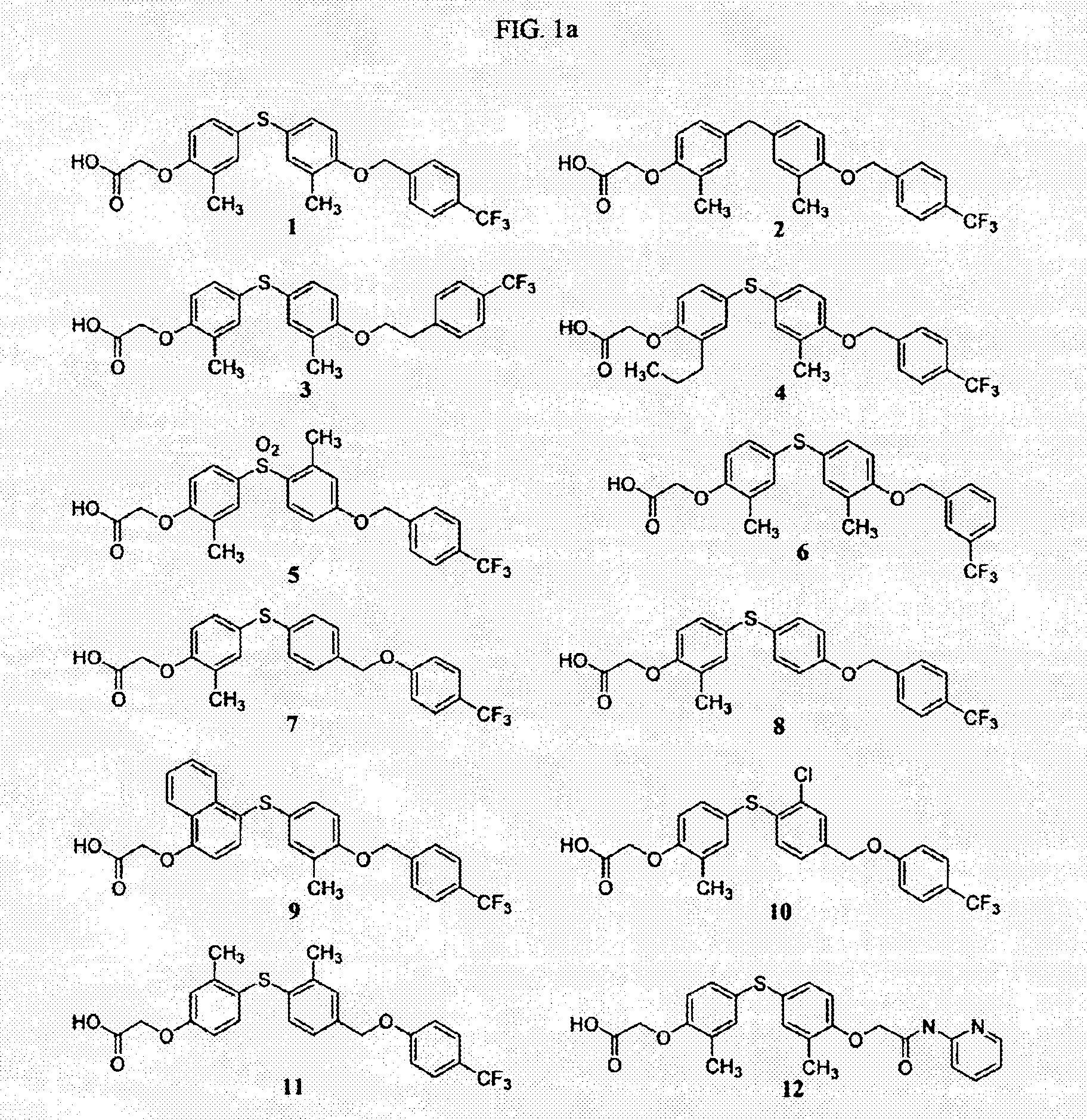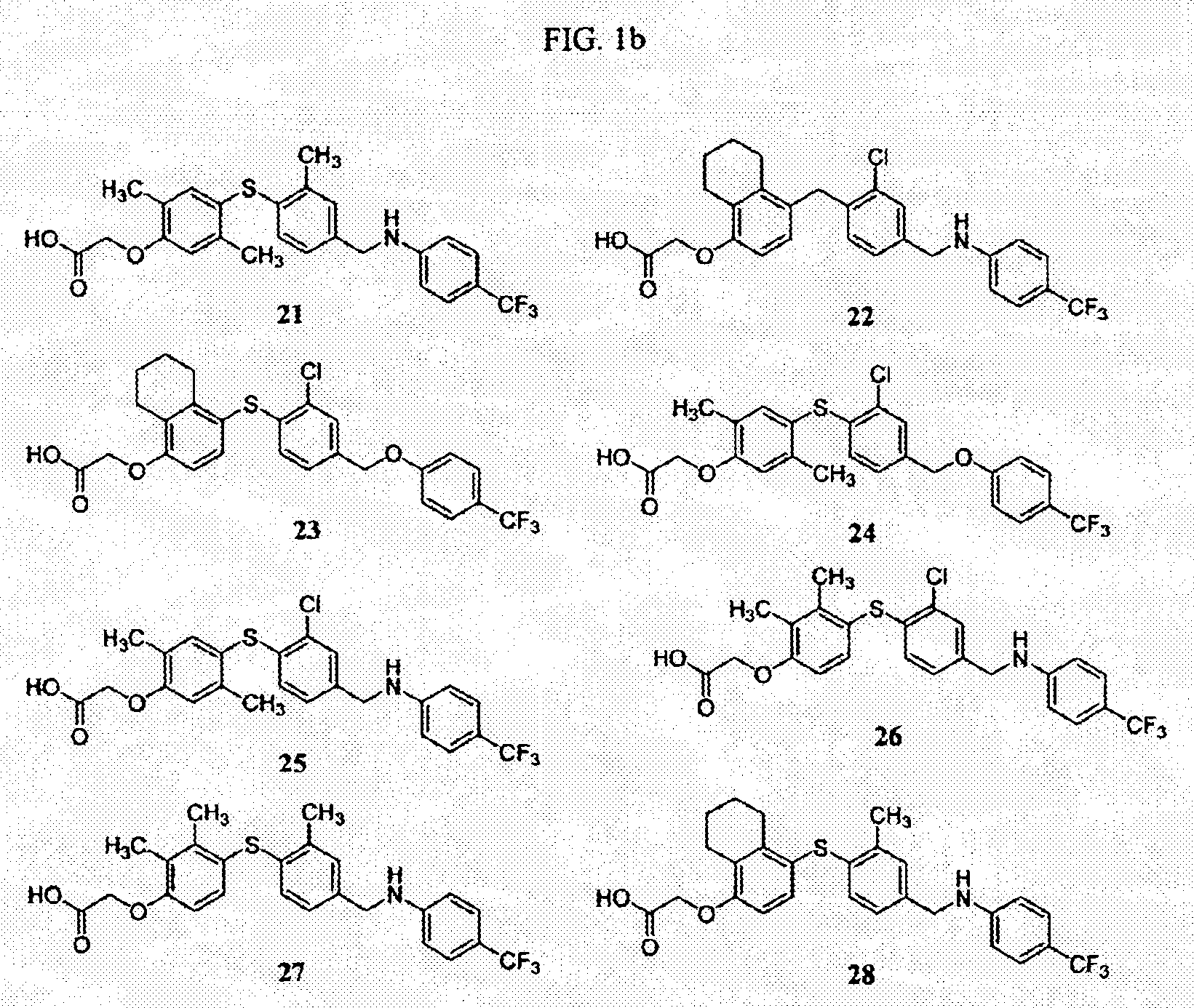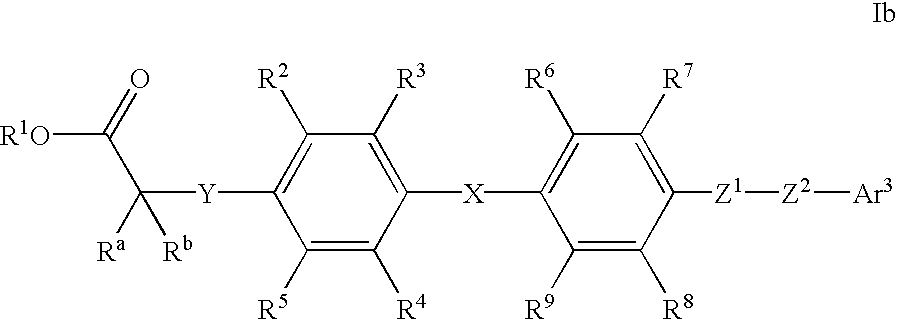Linked biaryl compounds
a technology of biaryl and compound, which is applied in the field of compound, can solve the problems that the risk of cardiovascular disease associated with low hdl cholesterol level is not sufficient to reduce the risk of cardiovascular disease in some patients, and the increased risk of cardiovascular disease associated with low hdl cholesterol level has not yet been successfully addressed
- Summary
- Abstract
- Description
- Claims
- Application Information
AI Technical Summary
Benefits of technology
Problems solved by technology
Method used
Image
Examples
example 1
This example illustrates the preparation of {2-methyl-4-[3-methyl-4-(4-trifluoromethyl-benzyloxy)-phenylsulfanyl]-phenoxy}-acetic acid (1).
[4-(4-Hydroxy-3-methyl-phenylsulfanyl)-2-methyl-phenoxy]-acetic acid tert-butyl ester (1.1). An oven-dried 100 mL round-bottomed flask was charged with bis-(4-hydroxy-3-methylphenyl)-sulfide (8.6 g, 34.9 mmol), finely powdered Cs2CO3 (11.9 g, 36.7 mmol), and anhydrous DMF (35 mL). Next, tert-butyl bromoacetate (5.2 mL, 34.9 mmol, Aldrich) was added dropwise, and the reaction was stirred vigorously overnight at room temperature. The reaction was poured into 500 mL of water and extracted with 3×50 mL of methylene chloride. The combined organics were washed with 2×150 mL of water, dried over Na2SO4, and concentrated to a slightly yellow oil. The mixture was then purified by flash chromatography (SiO2 gel 60, eluted with 10% hexanes in DCM—5% hexanes in DCM—100% DCM). The fractions containing only desired product 1.1 were combined and concentrated t...
example 4
This example illustrates the preparation of 4-[[3-methyl-4-(4-trifluoromethyl-benzyloxy)phenyl]sulfanyl]-2-propylphenoxy-acetic acid (4)
2-Methyl-1-(4-trifluoromethylbenzyloxy)benzene (4.1). 2-Methylphenol (12.53 g, 115.9 mmol) was dissolved in DMF (60 mL), and stirred at 0° C. To the solution was added K2CO3 (24.03 g, 173.9 mmol) and 4-trifluoromethylbenzyl bromide (23.08 g, 96.6 mmol), and the reaction was stirred at room temperature for 2 h. Water was added to the reaction, and the product was extracted with EtOAc twice. The organic layer was washed with water and brine, dried over Na2SO4, and concentrated in vacuo to give a crude residue. The crude residue was purified using silica gel column chromatography (hexane / EtOAc=30 / 1) to give 4.1 (25.1 g). 1H NMR (400 MHz) (CDCl3) δ 7.64 (2H, d, J=8.2 Hz); 7.56 (2H, d, J=8.2 Hz); 7.18-7.08 (2H, m); 6.90 (1H, t, J=7.2 Hz); 6.84 (1H, d, J=8.1 Hz); 5.14 (2H, s); 2.30 (3H, s).
2-Propylphenoxy-acetic acid ethyl ester (4.2). 2-Propylphenol (1...
example 5
This example illustrates the preparation of 4-[[2-methyl-4-(4-trifluoromethyl-benzyloxy)phenyl]sulfonyl]-2-methylphenoxy-acetic acid (5).
4-[[2-methyl-4-(4-trifluoromethyl-benzyloxy)phenyl]sulfonyl]-2-methylphenoxy-acetic acid ethyl ester (5). Compound 5.1 (90 mg, 0.18 mmol), prepared in a similar manner as described for compound 4.5 (see Example 4, above), was dissolved in dichloromethane (2.0 mL). To the solution was added 70-75% m-chloroperbenzoic acid (100 mg, 41-44 mmol) at 0° C. and the reaction mixture was stirred overnight at room temperature. Saturated NaHCO3 solution (5.0 mL) and NaS2O3 (100 mg) were added to the mixture, which was stirred at room temperature for 1 h. The product was extracted with dichloromethane (5.0 mL), and the organic extracts were successively washed with 1N NaOH solution (5.0 mL) and brine (5.0 mL), dried over Na2SO4, and concentrated in vacuo to give a residue which was purified using silica gel column chromatography (eluted with 0-30% AcOEt / hexane...
PUM
| Property | Measurement | Unit |
|---|---|---|
| insulin resistance | aaaaa | aaaaa |
| pharmaceutical composition | aaaaa | aaaaa |
| density | aaaaa | aaaaa |
Abstract
Description
Claims
Application Information
 Login to View More
Login to View More - R&D
- Intellectual Property
- Life Sciences
- Materials
- Tech Scout
- Unparalleled Data Quality
- Higher Quality Content
- 60% Fewer Hallucinations
Browse by: Latest US Patents, China's latest patents, Technical Efficacy Thesaurus, Application Domain, Technology Topic, Popular Technical Reports.
© 2025 PatSnap. All rights reserved.Legal|Privacy policy|Modern Slavery Act Transparency Statement|Sitemap|About US| Contact US: help@patsnap.com



